Schooling and Education
In the beginning
The first school in Badby was a charity school supported by the Knightleys of Fawsley. It was built in 1812 for the Lady Mary Knightley who married Sir John Knightley in 1779.
The school was named 'The Lady Knightley' and provided education for twelve poor girls. Board and clothing such as boots, shawls and bonnets were provided for the six younger girls and a person who lived in the village taught them domestic work including the spinning and weaving of sheets.
The six older girls were known as Lady Knightley girls and went to Fawsley Hall each day where the housekeeper there taught them how to cook, clean, make beds, set tables and even feed fowl. At the age of 12 they could leave school if they passed what was called a Labour Certificate examination which enabled them to start in a situation with a good knowledge of household work. Otherwise they stayed at school until they were 14.
The school building was used in later years as an infant school, supported by the Knightleys, until the County Council took over the education of the village children. The Old School House has now been listed as a building of historic interest.
(Source: Parish 2000 Badby Appraisal)
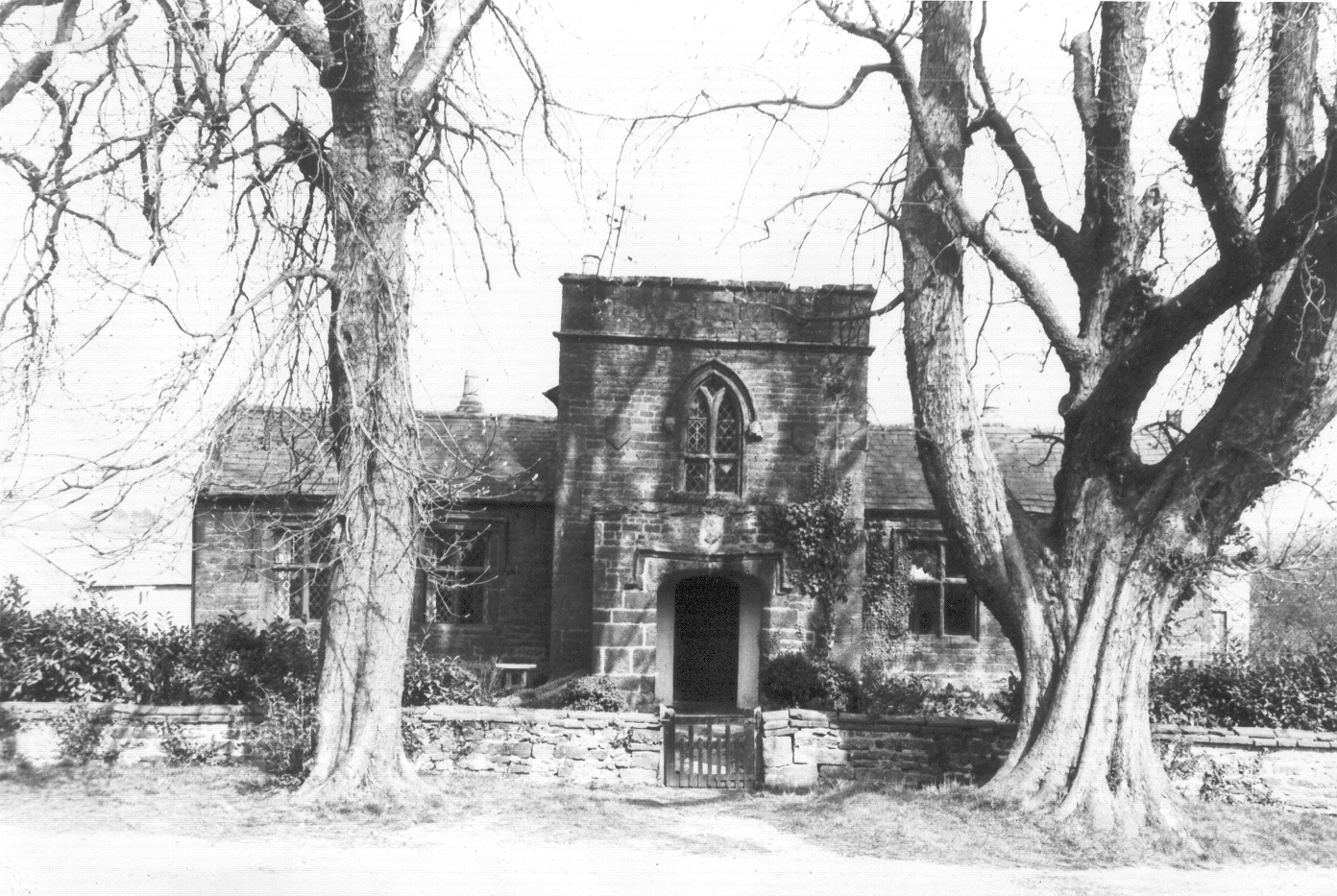 |
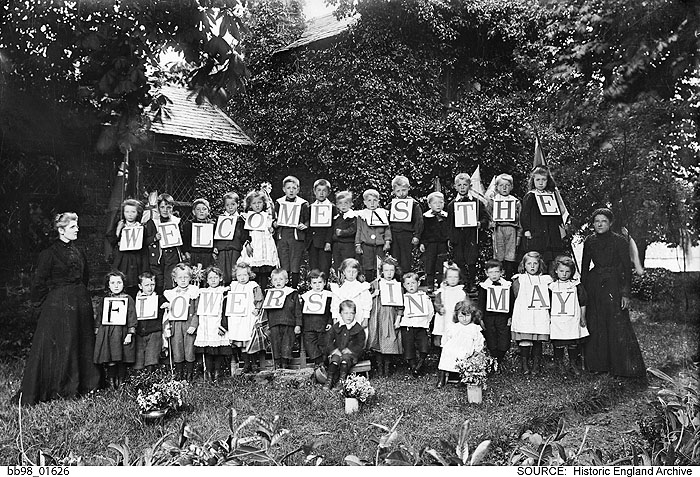 |
| The first school in Badby built in a design by Wyatt in a Gothic and Cruciform shape (photograph taken in the 1970s) (photo: HPoB&F, Badby PCC 2012) | Badby School c. 1896. A photo of school children taken on The Green with the school in the background. They are holding a welcoming message flanked by two school mistresses. (By permission of Historic England Archive) |
The National School
National Schools were founded in the 1800s by the National Society for Promoting Religious Education. These schools provided elementary education in accordance with the teaching of the Church of England to the children of the poor.
The National School in Badby was started in 1870 by Mrs Mary Green, the second wife of the Rev. Thomas Green who was the vicar in the village from 1816 to until he died in 1871.
Mrs Green gathered a number of church-going girls in the vicarage on Sunday afternoons to learn poetry and hymns. She then began to teach them to read and write and subsequently decided to take a cottage for this purpose.
Opposite the vicarage there was a workhouse, however, this building was later converted into three cottages to be disposed of by the vicar at his discretion. The poor lived in these cottages, however, when the first of these cottages became vacant Mrs Green started the school for girls. As soon as the next cottage became vacant it was taken for a school for boys and then the third cottage was finally added to the school.
These buildings eventually needed repairing and bringing up to acceptable standards, and the school board attempted to raise money by subscription for repair and extension. However, insufficient money could be found to do these and the National School was closed, while education of the village children passed to the County Council. In 1966 the building was declared unsafe and pulled down. Today the site is now used for car parking.
(Source: Parish 2000 Badby Appraisal)
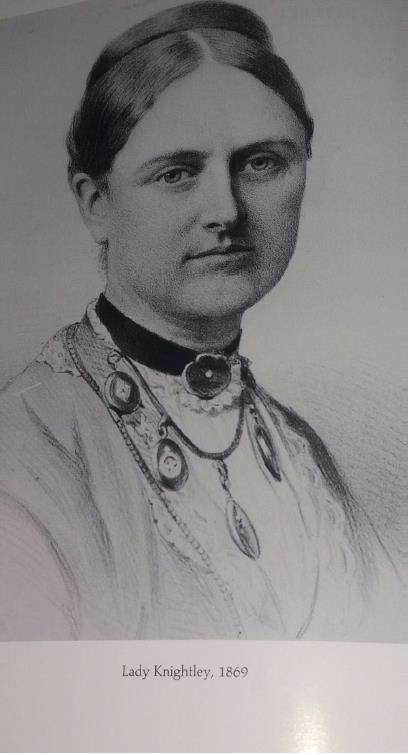 |
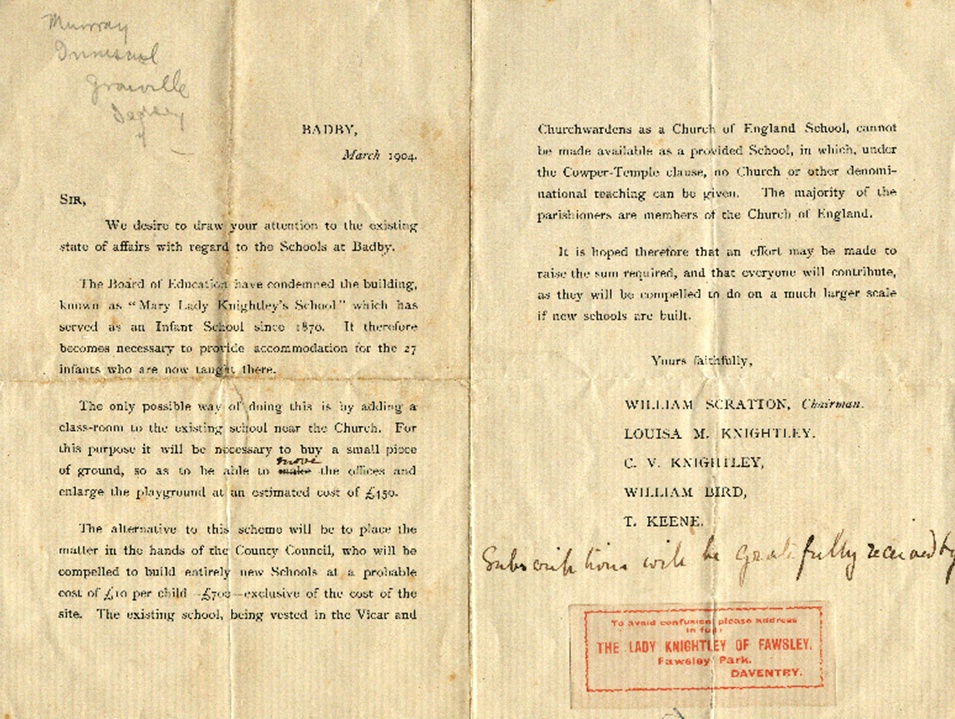 |
| Lady Knightley 1869 (Photo: from Politics and Society: The Journals of Lady Knightley of Fawsley 1885-1913, edited by Peter Gordon published by Northamptonshire Record Society) | Letter asking for subscriptions towards a new school, March 1904 (photo: HPoB&F, Badby PCC 2012) |
Lady Louisa Knightley
Lady Louisa Knightley from Fawsley supported and became a manager of the first school in Badby. Below are some extracts from her journals.
Tuesday, 10 December 1912:
"Went to Badby in the afternoon and had the pleasure of presenting the shield, prizes and medals won by the children in the Bird
and Arbor competition. Badby is very proud of having carried off the shield from much larger schools.
I made a little speech, and so ended the last function in the old Church of England school, for the new school is built, and is to
be opened next month."
[The shield Lady Knightley is referring to is the Challenge Shield for Northamptonshire awarded to Badby School children for Nature Study.]
Saturday, 4 January 1913:
"A pouring wet day, quite in harmony with the fiasco of the opening of the new Council School at Badby. We had arranged that Mr.
Monckton, as Chairman of the Education Committee, should do it, but he was detained so late that I had to do it instead, after Rev.
William Scratton (vicar in the village from 1871) had made a speech in which he abused Council Schools uphill and down dale, said
they put religion in the second place and were a national sin, etc.!!! I lost my temper and altogether it was a fiasco."
(Source: Politics and Society: The Journals of Lady Knightley of Fawsley 1885-1913, edited by Peter Gordon published by Northamptonshire Record Society)
Recollections from Miss A.E. Ivens about school life in the village in the early 1900s
"Early days at the turn of century school life was considered strict but enjoyable. Children used to take cake for their morning breaking carrying it in cambric bags tied with drawstrings and they always went home for lunch.
"One teacher at The Lady Knightley School had a maid who brought her warm milk in a white fluted cup and she would give sips of her milk to any delicate children.
"Old boys of the National School recall being taught to knit and getting their stitches so tight that they couldn’t get them off the needle; others particularly remember the big black stove of the new school on which the free milk was warmed.
"The children were supposed to walk straight home from school but if the vinegar seller was in the village the temptation to stop and turn on the taps of his barrel, while his back was turned, was great. Another game of dare was to tie together the adjacent door handles on the long rows of cottages which edged the greens, knock on the doors and wait for the chaos as neighbours tried to open them in vain!
(Source: Parish 2000 Badby Appraisal)
Celebrating May Day 1912
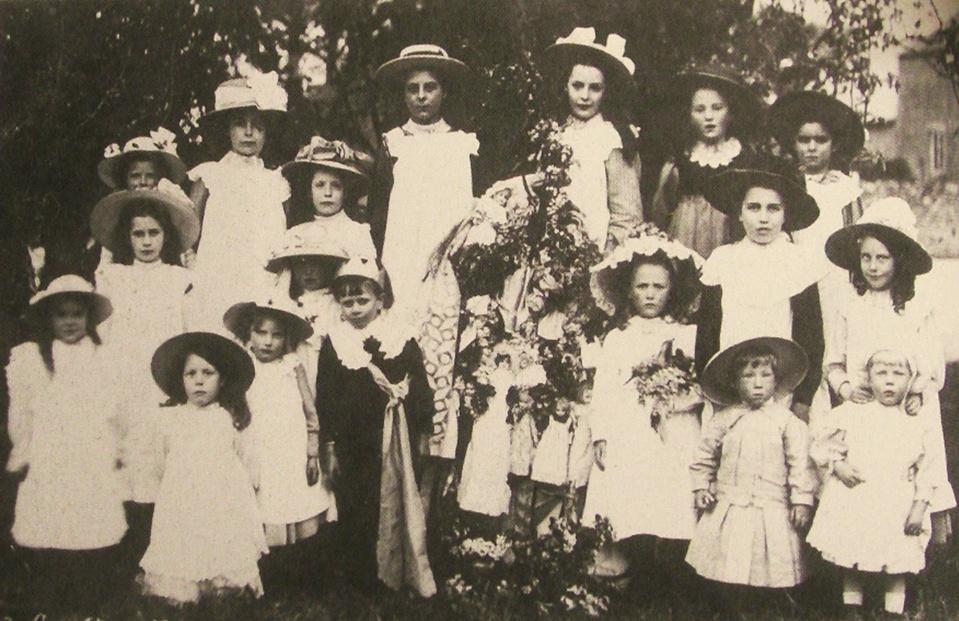
In the photo look for the May King and Queen!
(photo: HPoB&F, Badby PCC 2012)
The procession would go around the village and sing songs with the May garland which was a framework of hazel wood decorated with flowers.
Many years later May Day was replaced by the traditional Badby School Rose Day held every year in June or July. Celebrations include the crowning of an elected Rose Queen and King. Maypole dancing, fete and traditional country dancing from all the school children.
The Council School
The present Badby School, on School Lane, was built by the Council, opening in January 1913, on the site already used by the school children for gardening lessons. For some years the Council had the meadow behind the Hollies earmarked for a school playing field. When the Hollies was sold in 1965 the Council purchased the field and the playing area was completed in 1967.
The original Georgian school building was extended to include a science room, classrooms and hall and these were opened in 1975.
Nature study was taken seriously and the school pioneered nature trails in Badby wood and Fawsley Park. The children produced their own leaflets, printed in the school, which included a 'Badby Wood Nature Trail', 'Badby Discovery Trail' and a 'Historical Trail'. The leaflets gave properly marked out routes and described in detail trees, landmarks, flowers and vegetation, animals and bird to be seen in the area.
The school was rewarded for their interest in its surroundings and came second in a national competition sponsored by the British Tourist Authority and The Guardian newspaper. Headmaster, Mr. N.J. Lucas, went to London to receive a plaque from HRH The Duke of Gloucester. The plaque used to hang in the school vestibule - present-day teachers have looked for the plaque but unfortunately it cannot be found.
Recollections of Badby School from the 20th century
Three pupils who attended Badby School in the 20th Century present their recollections - Roy Barnett who attended from 1925 to 1935, and from Keith Bull and Ian Adamson who went in the 1950s.
Roy Barnett MBE
Below are some extracts of when Roy Barnett visited Badby school some years ago and spoke to the children about his memories of when he was a boy at the school. He was born in 1921 and lived in Bunkers Hill. His father was the butler at Fawsley Hall. In 2003. Roy was awarded the MBE for saving the lives of more than three million children in Third World countries simply by collecting five pence pieces.
Roy only went to Badby school and no other; he started in 1925 and left at the age of 14. It was different then from how it is today. He went into the infant class and had to learn to write but didn’t have a pen or pencil. They had slate, a piece of chalk and duster and when they went to go home their trousers were covered in chalk. If they used pen and ink they dipped the pen too far into the ink and had big blots on the paper and lost marks. They were allowed to use pencil and there was no lined paper. The paper had two different coloured lines. One blue narrow line and one big red line along the top and all the capital letters touched the red line and smaller letters had to be kept within the blue line. The was helpful in giving an idea if how big your writing would be.
Roy left the infants and went into middle class and then into the top class. Activities were very different from what they are today. Part of where the school is now was allotments and gardens. Two days a week the boys would dig vegetables and there used to be a stile. The headmaster, Mr. Rushworth, would walk across and over the stile into school. Where the playground is now there was a field where pigs, cows and sheep were kept.
Many children died before school age and some were at school. There were lots of diseases such as scarlet fever, diphtheria and tuberculosis. When this happened children were taken away to an isolation hospital in Staverton. With scarlet fever this would be for six weeks and would include the whole family. A lot of children had skin diseases and had to stay at home.
Roy had happy times. When he was twelve all the boys had to go and learn carpentry or woodwork on a Tuesday. They would finish school at 11.45am and walk to Daventry and back again. They didn’t take any notice in those days as this was normal. There were no buses at all.
The farmer’s son, Ivor, had a pet goat and the goat would follow Ivor to school. Sometimes in summer they would hear the goat butting his head against the classroom door. The goat would also them around the playground. Lots of children had pets.
When the boys went to carpentry the girls went to Daventry to learn to cook and when the boys were gardening, the girls learnt sewing and embroidery. Years ago if you had a hole in your sock you had to darn it and so girls had to learn to sew.
What sort of games did they play! Football, cricket, marbles and hopscotch. There were two playgrounds with high railings going down in middle. Boys were one side and the girls and infants the other.
There was no electricity or gas in those days and coke was delivered to keep the furnace going. The coalman delivered coke down into a manhole and the boys used to help. They got so dirty they had to go home for a bath! Because they could home the boys would volunteer for this.
Lunch was from 12.00 to 1.30pm and Roy would go home for his dinner. Quite often he had his main meal then because he had an hour and half.
Favourite game in the playground was ‘whip and top’ which was a piece of wood with a nail at bottom and a piece of leather attached. There was a football team, not just Badby but Everdon also.
Favourite subjects were maths, history and geography. Reading was most important and there was also poetry. One subject which endeared always to Roy was singing and which the school excelled at.
Very often had the dreaded homework. The rule in Roy’s house was that he did it when he got home and then he could go out and enjoy himself which he liked because if he hadn’t done before he went out he would have to do it when he got home.
Things have changed but some things in life haven’t over the years from when he came to school in that 5 + 5 still = 10 and 7 x 7 still = 49. He was taught that earth went around the sun and if you had something in your hand and let go gravity would make it fall. This is why you come to school you can rely on them because what you learn never changes.
Children didn’t have uniforms because people not well off those days. Boys wore jumpers and their hair cut short with a fringe. The reason for this was because of ‘nits’. Sometimes Roy would go to school in a blue jersey and the next week his brother went to school in same jersey. They would hand clothes to one another because couldn’t afford to buy clothes . Used to have boots rather than shoes and always had leather laces.
Roy left school and went to work in Northampton and made vacuum cleaners (not electric but manual ones that you pushed) for the liner, Queen Mary.
Five years after leaving school at 19 Roy went to war and came back after 5½ years. The was the only time he had been away from Badby. When returned came back in a taxi down Newnham Lane and saw Badby. The loveliest scene he had ever seen in his life!
Hobbies - most boys had a Meccano and played board games such as drafts, chess, snakes and ladders, ludo and card. They were encouraged to play dominos because it helped them to count. There was no electric in houses and they had oil lamps. The only light was from the flames of fire. Roy and his family used to sit around the fire talk to each other. There were no TVs or radios.
Very few children came to school in clothes that were new. They were always someone else’s that they had grown out, handed down from an older brothers or sisters, or second hand from jumble sales. This was nothing to be ashamed of as everybody was the same.
In the summertime Roy played in the woods quite a lot. He collected acorns for the pigs and every Saturday morning used have to go to collect beech wood because that was much better wood to burn.
May Day was celebrated and Roy was the last May King in Badby for many years. The procession would go around the village and sing songs with the May garland which was a framework of hazel wood decorated with flowers. Six or seven years ago this changed to Rose Day.
When Roy remembered playing around where the Dower House is and was told not to go there at night because there was a headless rider and he had his head under his arm!
Roy got the cane many times. One day Mr Rushworth’s cane broke and so the children were sent to the woods to get another one and they tried to pick one that would break again!
Keith Bull
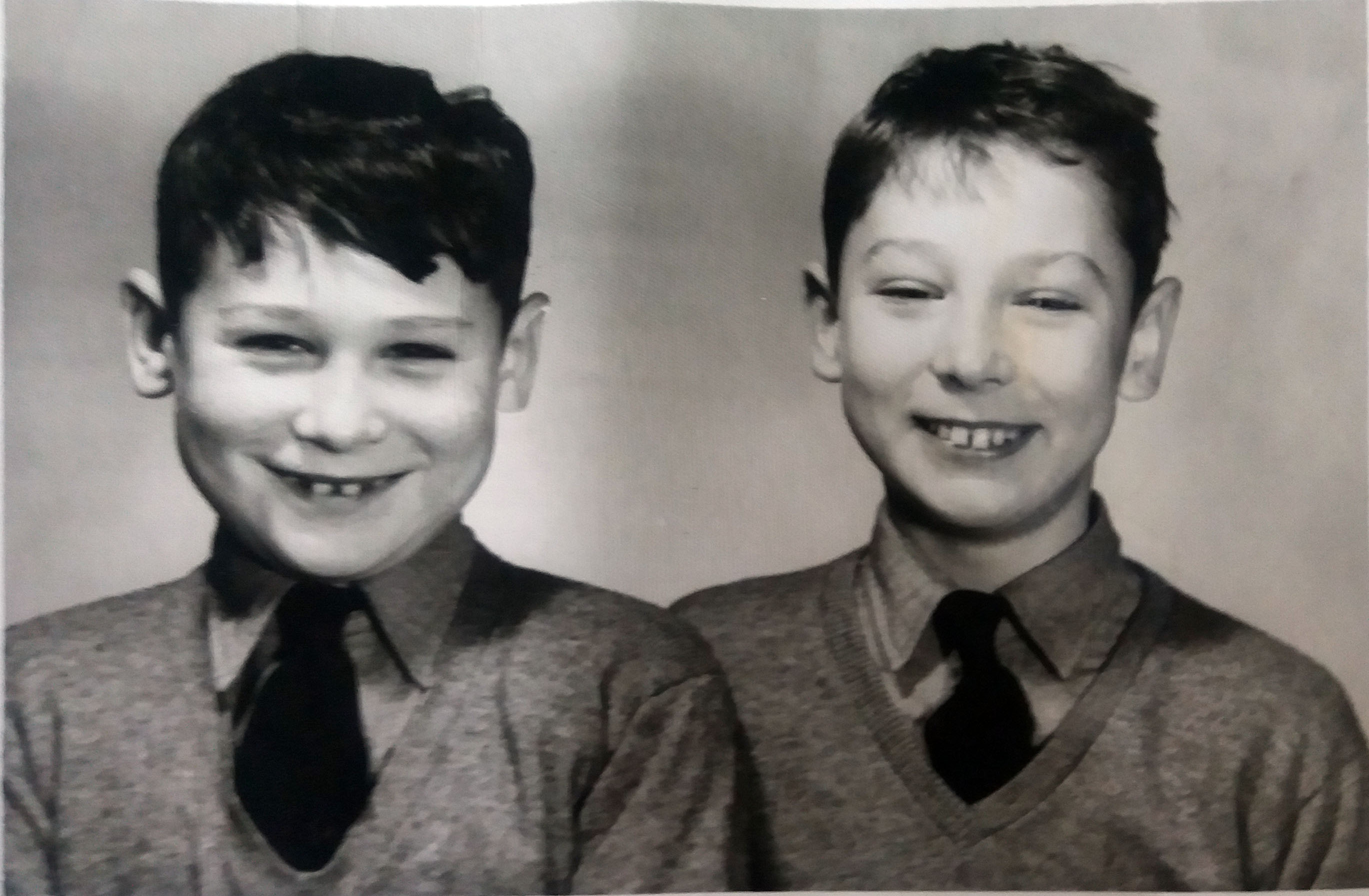
Keith Bull (right) with his brother Teddy (Photo: Keith Bull)
Keith has lived in Badby all his life and began school in 1952 at the age of 4 when School Lane was just a single track road with a slight bend which made it difficult to see from top to bottom. He left at the age of 11 and went on to Daventry County Modern School which is now the William Parker School.
The school had just three classrooms; infants, middle and top class, and there were approximately 12-15 children in each class. The headmaster was Mr. F. W. Harrison and there was one teacher for each age group. Mr. Harrison kept a diary which he completed daily and this included some misdemeanours of the children including Keith!
School started at 9.00am and finished at 3.30pm. Children would go home for lunch, however, first year children had lunch provided. Keith would walk home for his lunch and then come back and have a second one if it was available. There was a break in the morning and another one in the afternoon.
There was no uniform or school badge. Children would learn through books and teachers would use a blackboard. They used exercise books for each subject using a pencil or a nib dipped in an inkwell which was on the desk. Desks were wooden and had a lid on.
Lessons included reading, writing and arithmetic; arts and crafts where they made models, Christmas logs and candles. Sports day took place in the summer against Daventry teams and other villages. Practice was in the then cricket and football field (Long Roods as it was known) as the present field was not part of the school.
General knowledge tests were held every Friday. Children were also taught country dancing. They celebrated May Day and occasionally the children would carry the May garland around the village and dance around the Maypole.
School trips would include places such as London Zoo and Cheddar Gorge.
The playground is where it is now but half the size and included outside toilets and the stores. There was no playing field. Boys and girls played separately. Games included football, marbles and tag.
When Keith was 10 he became Head Boy. During Keith’s last year children picked rose hips on the weekends and given 5 old pennies per lb. These were collected by van to be processed into rose hip syrup.
Children were encouraged to have a pen pal from other schools and would correspond over several weeks.
Arthur T. Bull, Keith’s uncle, was probably the first pupil to register when the school opened in 1913.
Ian Adamson
About a school in the Vicarage set up for errant boys by the Vicar "What the school was, was a reform school not necessarily for really bad boys but boys who were a bit of a nuisance and were a little bit backward and the Vicar used to let them integrate with the kids of the village. One of them got married to a Daventry girl and he stopped with the Vicar, old Witham, right until he finished here. Lots of the boys used to come back and see old Witham you know. He was a lovely old man and his brother used to work at Uppingham Public School. He had an assistant with ginger hair who had an old Bedford Dormobile and he used to take the boys out and he had a Wolsey 15-40 top of the range with a walnut dashboard. Someone borrowed the car, took it out, drank too much and smashed it to bits. One of them threatened to jump off the roof. It was a 3-storey building and an old boy said he’d soon get him down, ‘I’ll get my big stick and soon get him down’." (circ. 1951)
About Badby School "You were about 8 before you got into the bigger boys. There used to be 2 classrooms then, as the village got a bit bigger, you had an annexe classroom which was the third one but prior to about 1955, 56, 57, about that time, you started here at 4 years old and came out when you were 14. It was only sort of later that you went to Daventry unless you won a scholarship to the Grammar."
Memories of Badby Village 1957–64 by Jane (Fletcher) and Deborah (Chapman)
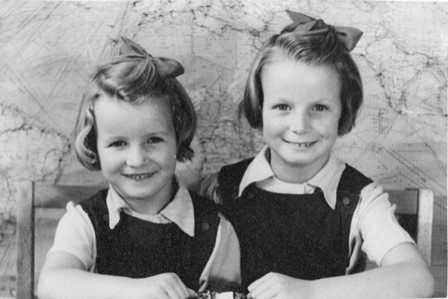
Deborah (age 5) and Jane (age 8) in summer 1958
(photo: Jane Fletcher & Deborah Chapman 2022)
During the Easter holidays in 1957, Jane aged 7 and Deborah aged 4 along with their parents moved into the Laurels, the house assigned to the headteacher of Badby County Primary School. Their father Mr F.W. Harrison began a seven-year position as Headteacher at the start of the Summer Term supported by Miss Bufton (Infants), Miss Mason, (Lower Juniors), Mrs Walkling, (Caretaker) and Mr Webb (Chair of Governors), the latter being a retired Policeman who lived at Swiss Cottage.
The school day began with Assembly in the hall which doubled up as the Library. A hymn, a reading and the Lord’s Prayer followed by a Thought for the Day, often a proverb such as “Great Oaks from Little Acorns Grow”, trying to get us all to think that we may be small in the general scheme of things but should aspire to be big and strong in the future. Such was their father’s approach to the school experience, perhaps founded during his service in the Royal Air Force in World War Two, he wanted all of us to broaden our horizons.
One Assembly remains firmly fixed in their memories. An older boy at the back kept fidgeting, “Stand still, What is the matter?”, John Warr promptly pulled a grass snake from his sleeve, Jane Trotman fainted and hit her head on a radiator. A lesson in First Aid quickly followed and John was dispatched to release the snake. The rest of us filed back to our classrooms. Deborah to Miss Bufton’s.
“At the age of four, I was not speaking very well and lived in my own little world. My father despaired of me at times, any attempt he made in helping me to speak or concentrate met with little response. In desperation he took me to school with him and asked the Infant teacher Miss Bufton to help me in any way she could. Within six weeks I was talking, reading and writing. I loved every minute in her class. I remember that at the end of every day we sat around the fireplace and she read us a story. Each day one of us would be rewarded with a piece of cake. She gave me a love of books which I still have today.”
Jane went to Miss Mason’s for one term before being moved up to her father who took the Top Juniors. In Top Juniors, Monday morning began with the majority of pupils making entries into their diaries, while a few were asked to speak to the class about what they had done over the weekend.
Keith Ball in his article above summed up the school day and this reminded Jane of other activities. These included BBC Schools Radio Broadcasts:
- Singing Together, on Mondays (the focus of which was English folk songs);
- Nature Study, on Wednesday afternoons
- Time and Tune, on Thursdays.
In addition, the class took part in an Annual National Bird and Tree competition which involved in-depth studies of choice. A project on a Business, which taught us how to write letters to companies, asking them for information. Cadburys, Rowntrees, Brooke Bond were favourites because they sent samples of their products. Alas, Raleigh Cycles did not!!
Postmarks were collected to stick on a map of the British Isles and beyond to teach us place and location. Rainfall, temperature, wind speed and direction values were recorded daily and sent to the local Met. Office.
Each pupil had an exercise book called ‘My Little Book of Knowledge’, a book of facts of countries and capitals, proverbs, similes, tables of weights and measures etc., tested on Friday afternoons as Keith recalls.
A Parent Teacher Association was set up to raise much needed funds to ensure all pupils could take part in general school/village outings and more local activities such as the Annual Schools Carol Service in Daventry where Badby School was allocated a reading, St Luke, Chapter 2, verses 8 – 16. Both Jane and Deborah were called upon to read this and can still recite it to this day.
The Annual Schools Drama and Music Festival at Daventry County Modern School was the highlight of the year and in 1961 Badby School was invited to represent Northamptonshire at the International Folk Dance Festival at the Royal Albert Hall. Deborah took part in this and remembers: “My mother organised the dresses we would wear, each one a pastel colour with a contrasting sash. She made mine and probably others too. An amazing day and since I have visited this place again for concerts I can still see us dancing on the floor with such enthusiasm.”
In 1960 Jane left Badby School for Northampton High School for Girls, followed by her sister three years later. After A levels they followed their father into the teaching profession, each serving thirty-five years in various schools in Buckinghamshire. Jane in Secondary (Grammar and Comprehensive) and Deborah in Primary.
Miss Bufton retired in 1959 to be replaced by Mrs Quinn, wife of the village policeman. Miss Mason retired in the summer of 1962. Falling rolls and education cut backs, led to Badby School having only two classes from Autumn 1962 run by Mr Harrison and Mrs Jones. The family left Badby at the end of the Summer Term 1964, when Mr Harrison returned to his home village of Duston to take up appointment as Headteacher of Duston Eldean Primary School. This had a staff of fifteen!
Badby Primary School as it is today
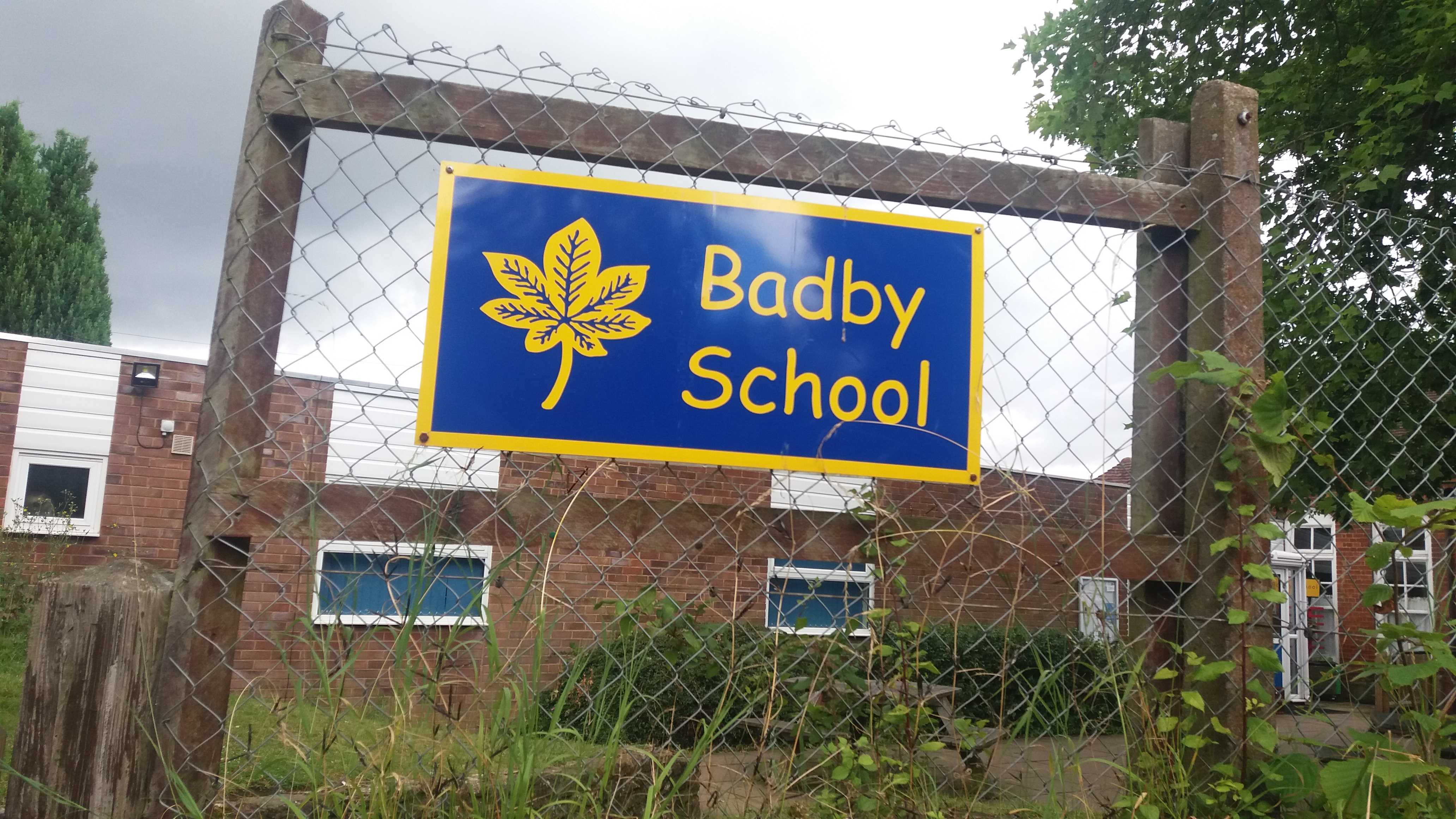 |
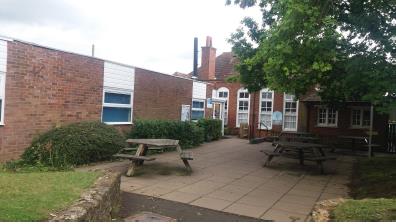 |
| Badby School sign (Photo: Lynne Green) | Badby School showing part of the original building (Photo: Lynne Green) |
The original school had what was called the infant hall and two additional classrooms which are still there today. In the 1970s the school was extended to include an additional seven classrooms and a large hall.
The hall is used for many activities including assemblies, PE and there is a stage for school performances such as Christmas pantomimes and end of year school plays. Children also have their lunch in there.
There are seven classes which are for Reception and Years 1-6. There is a teacher and teaching assistant for each class and up to 25 children in a class.
The age range is from 4-11 years. At 11 years old they leave and go on to a range of secondary schools.
Also within the school there is Bluebells Pre-school which is a small and friendly nursery for children from age 3 years which was established in 2011 by the Badby School governors.
 |
 |
| Bluebells Pre-school (Photo: Lynne Green) | “The Pod” (Photo: Lynne Green) |
The school gate opens at 8.40am and registration is between 8.50 to 8.55am. School finishes at 3.30pm. Reception and Class 1 finish at 3.20pm. There are breaks in the morning and afternoon. Lunch is from 12-1.00pm and children can either bring a packed lunch or have a hot meal which is prepared in what is called “The Pod".
Most children come to school by car, very few walk to school these days.
Lessons include maths, reading, RE, science, PE, French, IT and sports. Children learn by using information technology and interactive whiteboards.
 |
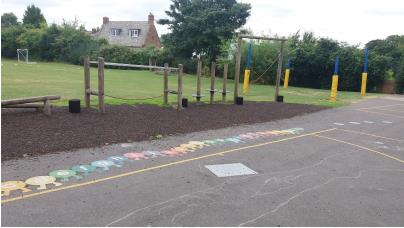 |
| The school library (Photo: Lynne Green) | The playground and playing field (Photo: Lynne Green) |
There is one playground which includes playing fields and climbing frames where both girls and boys play. Games include football and hopscotch. There are also table-top games such as snakes and ladders, drafts and table tennis.
Children go out of school for walks around the village and Badby woods throughout the year especially in May to see the bluebells. Visits outside the village include botanical gardens and the Derngate theatre to see the Christmas pantomime each year. Various theatre and history groups also visit the school.
Pupils also help to organise the annual Macmillan Coffee Morning in the village hall.
There are extra curriculum activities during lunch times and after school. These include football, basketball, knitting, chess and games club, arts and crafts.
For many years the highlight of the school year has been the “Rose Day” event when the elected Rose King and Queen are crowned at a ceremony held in June or July and incorporating Maypole dances. This replaces the traditional May Day celebrations.
(Compiled by Lynne Green with the help of a teacher at Badby Primary School, July 2017)
Badby School Centenary 2013
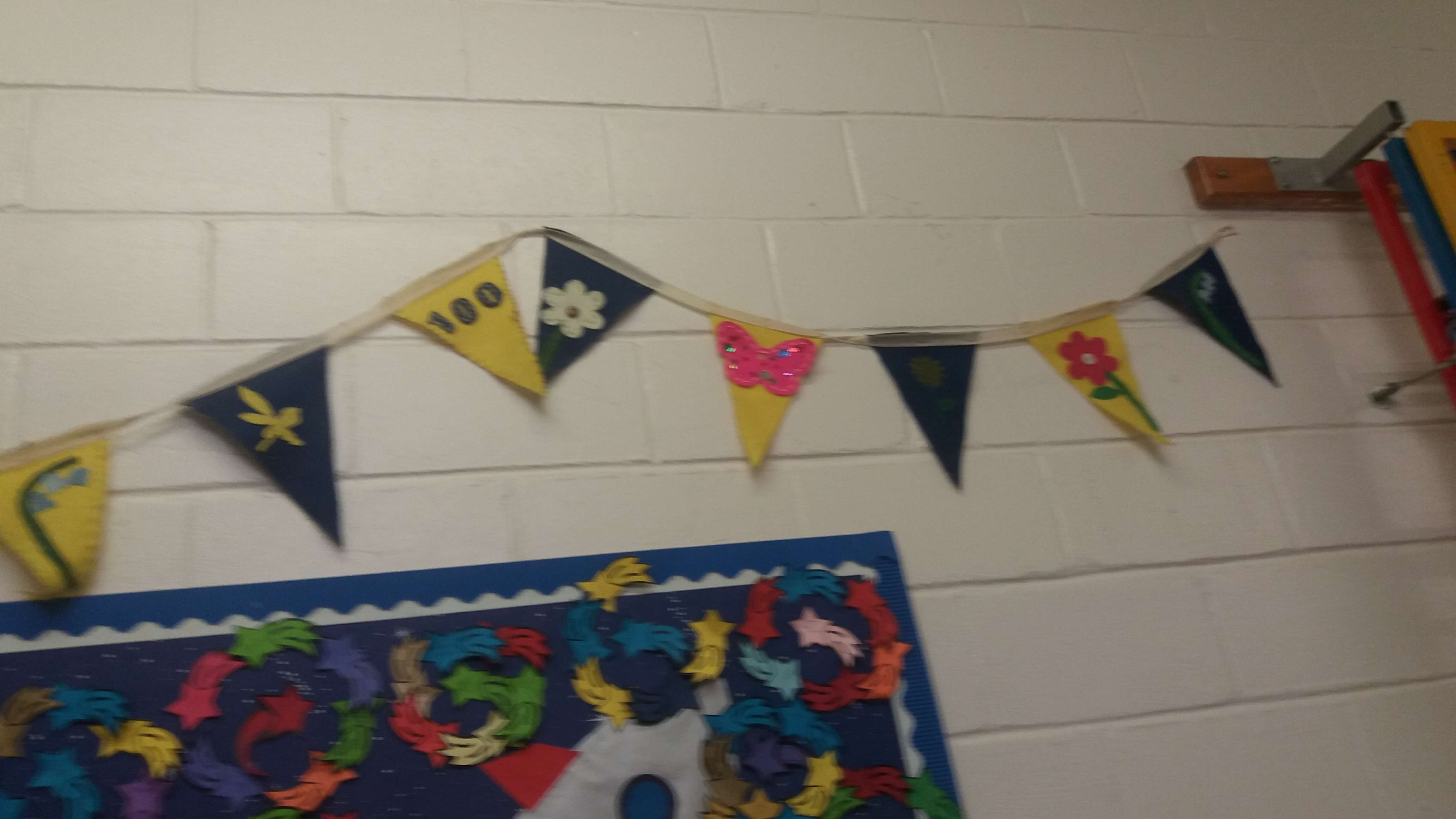
Bunting made by the children to celebrate the school’s
centenary (Photo: Lynne Green)
In February 2013, the school celebrated its 100th birthday with a week of exciting events.
Each class investigated and explored life in a different decade from 1913 to 2013 finding out about music, fashion and key events in history.
Pupils also spent a day learning as the children would have in 1913. They used chalk and a slate board instead of laptops to write, sat in rows and learned to use the handwriting style from long ago.
Past pupils, teachers and headteachers came to visit in class and attend an evening party, including the school's oldest living past pupil, Mr Roy Barnett, who was 94 years old at the time.
At the end of the week a birthday party was held with a disco and birthday cakes.
(Source: Badby Primary School Website)
School in the present day and how different it was from the 1800/1900s!
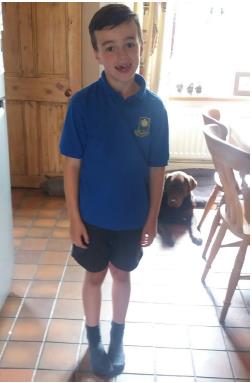
George Hopcraft (Photo: Leonie Hopcraft)
George Hopcraft is 8 years old and lives with his mum and dad in Everdon. He goes to Badby Primary School.
George travels on the mini-bus that takes him and other children to school every day. The bus collects him at 8.20am and he and is home at 3.45pm. Mums, siblings and pets wait on the village green for the children to arrive home. He then goes out to play with his friends from the village.
School starts at 9.00am and lessons include RE, English, maths and PE. Nowadays there are no music lessons. PE is George’s favourite. He has a teacher and teaching assistant to teach him his lessons. The children learn from using the internet, text books, and exercise books using pencils.
Lunch is from midday to 1.00pm and George can either take a packed lunch or have a hot meal which is free for Reception, Years 1 and 2 children, Years 3, 4, 5 and 6 have to pay. George takes mum’s sandwiches except on a Wednesday when it is a roast dinner!
George likes to play football in the playground. He doesn’t know what the girls play!
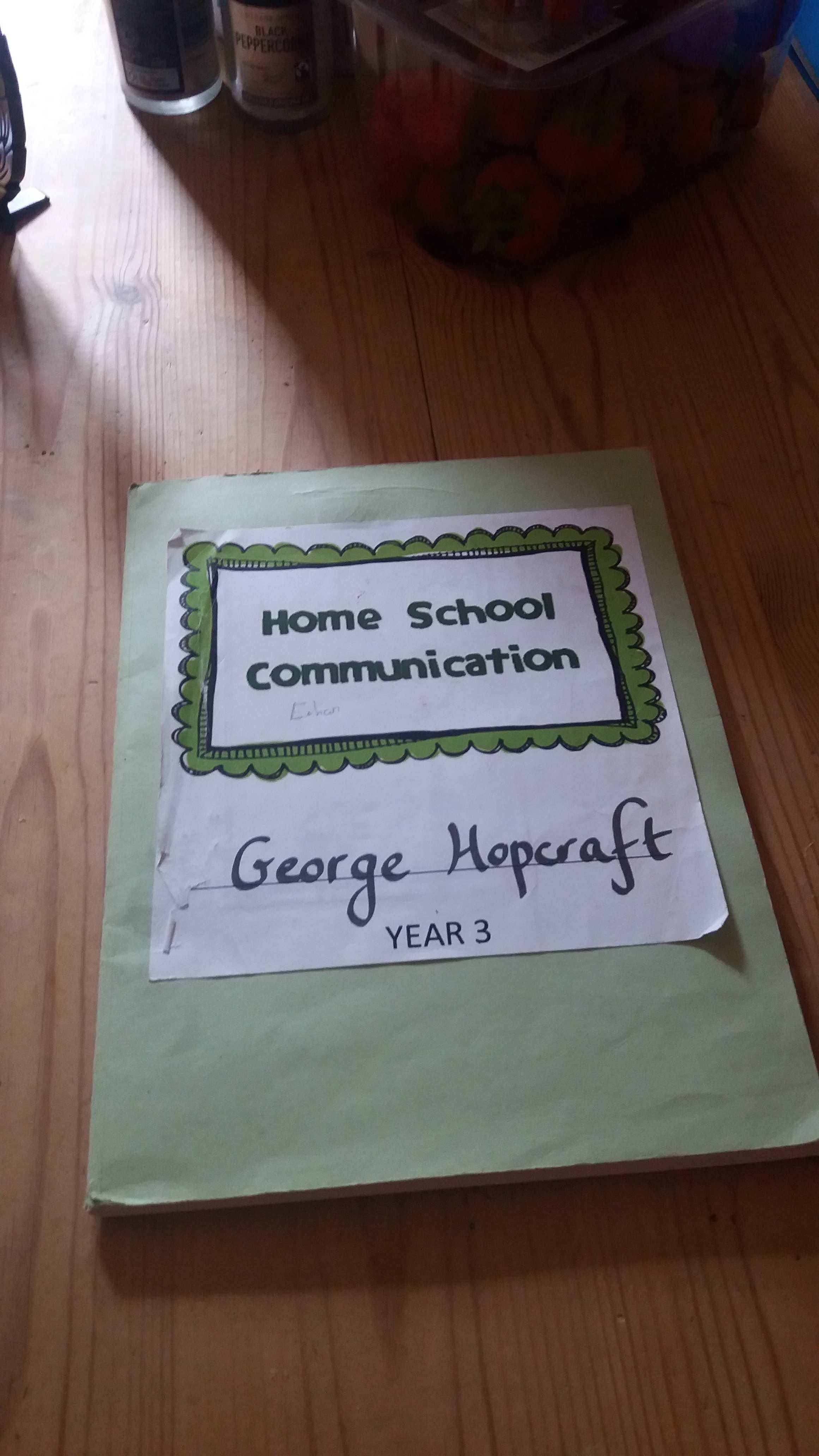
George Hopcraft's Home School
Communication book (Photo: Leonie Hopcraft)
There are lunch time clubs and after school activities which include basketball, netball, chess, knitting and many more. George plays basketball. He also plays football Friday lunchtimes.
A 'Home School Communication' book is used and is a way of communicating between George’s teacher and his mum and dad. It is especially useful for parents or carers who do not go to the school everyday. This lets the teacher know what he has been reading or if he has done something good at home, i.e. George was recently in his team’s football final.
New to the school is an internet-based website called 'Class Dojo'. It is a communication a bit like Facebook between the school and parents and gives all sorts of information such as photographs of what children have been doing at school or on schools trips, reminders for 'Mufti Days', i.e. dress down days, and school events such as Rose Day. George’s mum can even let his school know if he is going to be late.
Last updated 21 December 2022